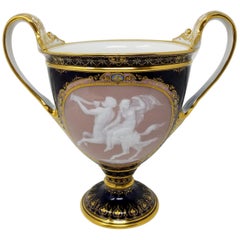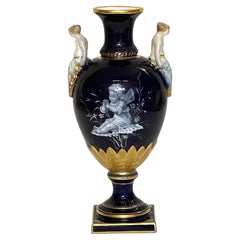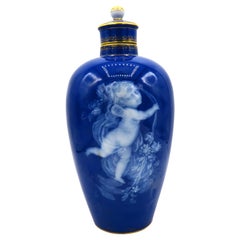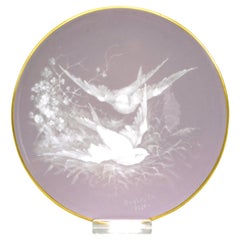Meissen Pate Sur Pate
Meissen Pate Sur Pate Vase of a Neoclassical Maiden Seated on Centaur
By Meissen Porcelain
Located in New York, NY
A 19th century Royal Cobalt Blue Meissen Pate Sur Pate vase of a Maiden seated on a Centaur
Category
Antique 1860s German Neoclassical Vases
Materials
Porcelain
$68,500
H 10.75 in W 11.5 in D 7.5 in
Meissen Cobalt Ground Pâte-sur-pâte Figural Vase, Attributed to Leuteritz
By Meissen Porcelain, Ernst August Leuteritz
Located in West Palm Beach, FL
Meissen Cobalt Ground Pâte-sur-pâte Figural Vase, attributed to Leuteritz
Germany, second quarter
Category
Antique Late 19th Century German Vases
Materials
Porcelain
$4,760 Sale Price
20% Off
H 5.75 in W 3 in D 2 in
Recent Sales
19th Century Meissen Pâte sur Pâte Vase
By Meissen Porcelain
Located in Remshalden-Grunbach, DE
19th century Meissen Pâte sur Pâte vase.
Wonderful Meissen Pâte sur Pâte vase. Hand decorated
Category
Antique Late 19th Century German Porcelain
Materials
Porcelain
19th Century Unique Meissen Pâte Sur Pâte Plate Painting Signed by Baylac Fils
By Meissen Porcelain
Located in Remshalden-Grunbach, DE
19th century unique Meissen Pâte sur Pâte plate painting signed by Baylac Fils
Meissen Unikat
Category
Antique Late 19th Century German Porcelain
Materials
Porcelain
Meissen Pate Sur Pate Porcelain Centerpiece Depicting Cupid and Psyche
By Meissen Porcelain
Located in New York, NY
A very fine and rare Meissen Pate Sur Pate porcelain centerpiece. Depicting cupid and psyche
Category
Antique Mid-19th Century German Rococo Revival Centerpieces
Meissen Pâte-Sur-Pâte Vase Two Panels of Female Face in Profile View Made
By Meissen Porcelain
Located in Vienna, AT
Meissen most remarkable item:
Pâte-Sur-Pâte vase, decorated with two Panels showing female face in
Category
Antique 1880s German Other Porcelain
Materials
Porcelain
Museum Quality Meissen Porcelain Cobalt-Blue Krater Pate sur Pate Vase
By Meissen Porcelain
Located in New York, NY
A magnificent and truly unique Museum quality Meissen porcelain cobalt-blue krater pate sur pate
Category
Antique Mid-19th Century German Neoclassical Revival Porcelain
Materials
Porcelain
Meissen Porcelain Pate Sur Pate Signed Box with Portrait of Bride Wearing a Veil
By Meissen Porcelain
Located in New York, NY
A beautiful 19th century pink and yellow Pate Sur Pate Meissen porcelain box with a portrait of
Category
Antique 1850s German Louis XVI Decorative Boxes
Materials
Porcelain
People Also Browsed
French Empire Revival 19th Century Giltwood Carved Figural Console and Mirror
Located in Los Angeles, CA
A fine French Empire Revival 19th century giltwood and Gesso carved figural console table with matching mirror. The "D" shaped top console raised by a pair of seated winged sphinxes ...
Category
Antique Late 19th Century French Empire Revival Console Tables
Materials
Marble
$59,600 Sale Price / set
20% Off
H 120 in W 48.5 in D 24.5 in
Body of Art Book
Located in New York, NY
"Body of Art juxtaposes Sandro Botticelli's Venus with Vanessa Beecroft's army of naked women, the iconic head of Nefertiti, and the work of Ryan Trecartin, among many other artists,...
Category
21st Century and Contemporary Books
Materials
Paper
Limoges France Trinket Box Baseball Glove
By Limoges
Located in San Juan Capistrano, CA
A charming Limoges Porcelain Trinket Box in the shape of a baseball glove. This piece is hand-painted and hand-crafted. The bottom of the box is marked Limoges France. This rare piec...
Category
Mid-20th Century French French Provincial Decorative Boxes
Materials
Brass
Antique English Victorian Mahogany Watch Box
Located in Northampton, GB
Fully Lined Interior
From our Jewellery Box collection, we are pleased to offer this Antique Mahogany Watch Box. The Watch Box of slender rectangular form made from solid Mahogany w...
Category
Antique Late 19th Century English High Victorian Jewelry Boxes
Materials
Brass
Cookbook Book
Located in New York, NY
Featuring 125 seminal cookbooks from the last 100 years, Cookbook Book is a celebration of the world's most beautiful, influential and informative cookbooks.
From the tried-and-tr...
Category
21st Century and Contemporary Chinese Books
Materials
Paper
Maitland Smith Embossed Leather Stacked Books Trompe-l'œil Coffee Table, Signed
By Maitland Smith
Located in Los Angeles, CA
Impressive trompe-l'œil leather book coffee table by Maitland Smith, circa 1990, that would make a fantastic conversation starter for any space. The whimsical table's surface is made...
Category
1990s American Modern Coffee and Cocktail Tables
Materials
Leather, Wood
$3,550 Sale Price
26% Off
H 16.5 in W 36 in D 29.5 in
Shells Table Cups in Porcelain and Bronze
Located in Paris, FR
Table cups shells in hand-painted porcelain
and with structure in bronze.
Category
21st Century and Contemporary Italian Porcelain
Materials
Bronze
1970s Astonishing Swift 1778 Model Ship. Handmade. Made in England
Located in Milano, IT
1970s Astonishing Ponant model ship in walnut wood. Handmade. Made in England. This model is amazing and in excellent condition and all handmade. A true piece of history.
Dimension: ...
Category
Vintage 1970s English Mid-Century Modern Models and Miniatures
Materials
Wood
Vintage Blue Pop Art APC Pouring Paint Can Bank
Located in Brooklyn, NY
A perfectly Pop Art 1980s pouring paint can piggy bank/sculpture. Metal paint can with a quarter-sized coin slot in its bottom appears to be defying gravity by resting on a pouring ...
Category
Late 20th Century Post-Modern Models and Miniatures
Materials
Metal
A French 19th-20th Century Ebonized Wood & Plated Surtout de Table Centerpiece
By Gianmaria Buccellati
Located in Los Angeles, CA
A very fine French 19th-20th century neoclassical revival style ebonized wood and figural silver plated mounted plateau Surtout de Table centerpiece in the manner of Buccellati. The ...
Category
Antique Early 1900s French Neoclassical Revival Centerpieces
Materials
Wood
$9,850 Sale Price
23% Off
H 5.25 in W 26 in D 22 in
Vintage Decorative gramophone horn in wood
Located in Linkebeek, BE
Decorative gramophone horn in wood
Antique - Decoration - Phonograph
Materials : Wood - Metal
Wear consistent with age and use : See photos please
Category
20th Century Industrial Musical Instruments
Materials
Metal
Large Taxidermy Blue and Gold or Blue-and-Yellow Macaw
Located in New York, NY
Taxidermy Blue-and-Yellow Macaw (Ara ararauna)
The blue-and-yellow macaw, also known as the blue-and-gold macaw, is a stunning Neotropical parrot. This taxidermy specimen showcases ...
Category
21st Century and Contemporary American Victorian Taxidermy
Materials
Feathers
Continental Horn and Oak Gun Cabinet
Located in Queens, NY
Continental German (19th Century) horn and oak gun cabinet with deer carved pediment.
Category
Antique 19th Century German Rustic Cabinets
Materials
Oak, Horn, Glass
1970s Astonishing Belem Model Ship. Handmade. Made in England
Located in Milano, IT
1970s Astonishing Belem model ship in walnut wood. Handmade. Made in England. This model is amazing and in excellent condition and all handmade. A true piece of history.
Dimension:
...
Category
Vintage 1970s English Mid-Century Modern Models and Miniatures
Materials
Wood
Italian Venetian Grotto Carved Seashell Rocker
By Pauly & Co.
Located in Queens, NY
Italian Venetian Grotto (19th cent.) silver gilt rocker with carved seashell seat & back and seahorse sides (att: Pauly et Cie, Venice)
Category
Antique 19th Century Italian Baroque Rocking Chairs
Materials
Silver Leaf
"More Bench" Four-Seat Upholstered Sectional Wood Frame Sofa by Moroso, Diesel
By Moroso, Diesel Creative Team 1
Located in Brooklyn, NY
"More Bench" is a four-seat sectional sofa, designed by Diesel Creative Team and manufactured by Moroso, featuring stress-resistant polyurethane foam with differentiated densities an...
Category
21st Century and Contemporary Italian Modern Sectional Sofas
Materials
Leather, Fabric, Velvet, Wood, Ash
$6,369 / item
H 39 in W 96 in D 33.5 in
Get Updated with New Arrivals
Save "Meissen Pate Sur Pate", and we’ll notify you when there are new listings in this category.



